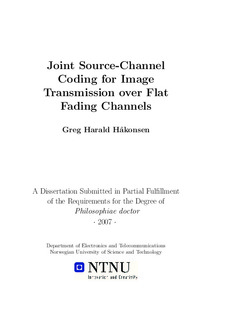| dc.contributor.author | Håkonsen, Greg Harald | nb_NO |
| dc.date.accessioned | 2014-12-19T13:42:32Z | |
| dc.date.accessioned | 2015-12-22T11:39:43Z | |
| dc.date.available | 2014-12-19T13:42:32Z | |
| dc.date.available | 2015-12-22T11:39:43Z | |
| dc.date.created | 2007-10-18 | nb_NO |
| dc.date.issued | 2007 | nb_NO |
| dc.identifier | 122796 | nb_NO |
| dc.identifier.isbn | 978-82-471-2999-9 | nb_NO |
| dc.identifier.uri | http://hdl.handle.net/11250/2368795 | |
| dc.description.abstract | In this thesis, transmission of images over a at fading channel using joint source-channel coding (JSCC) is considered. Through the use of nonlinear dimensional changing mappings, the system becomes robust. The system will not experience a clear breakdown, but have a graceful degradation which is visually pleasant. It is shown how multiple ways of adapting the source to the channel, and using the knowledge about the channel, results in a performance comparable to state-of-the-art systems but with less complexity. By relying on the robustness, reduction in channel information does not mean a large loss in performance.
The proposed system has low computational complexity as there are no separate source and channel coders. Compression and generation of channel symbols are done in one operation. By using nonlinear dimensional changing mappings, the dependency between the channel symbols are low. This leads to a system where the received image can be progressively decoded, and where the received information is still usable if the transmission stops unexpectedly.
By allowing a small variation around target time and transmission power constraints, the variation of the quality of the received image is kept small. This is done through planning and on-the-fly adaptation of the transmission. The planning depends on the distribution of the channel quality, and makes sure the channel is used bandwidth efficiently.
Through the results, the impact and importance of the design of some of the system parameters are analyzed and discussed.
By using theoretical models, it is shown how practical limitations of the system contributes to loss in performance. Similar techniques are also used to analyze where in the system effort should be made to improve the system.
The proposed system has a framework that can be easily extended to other scenarios. | nb_NO |
| dc.language | eng | nb_NO |
| dc.publisher | Fakultet for informasjonsteknologi, matematikk og elektroteknikk | nb_NO |
| dc.relation.ispartofseries | Doktoravhandlinger ved NTNU, 1503-8181; 2007:136 | nb_NO |
| dc.title | Joint Source-Channel Coding for Image Transmission over Flat Fading Channels | nb_NO |
| dc.type | Doctoral thesis | nb_NO |
| dc.contributor.department | Norges teknisk-naturvitenskapelige universitet, Fakultet for informasjonsteknologi, matematikk og elektroteknikk, Institutt for elektronikk og telekommunikasjon | nb_NO |
| dc.description.degree | PhD i elektronteknikk | nb_NO |
| dc.description.degree | PhD in Electrical Engineering | |
